Jiawei Ren
Feed-Forward Bullet-Time Reconstruction of Dynamic Scenes from Monocular Videos
Dec 04, 2024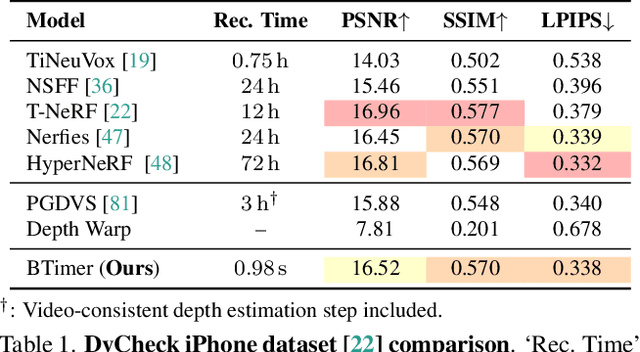
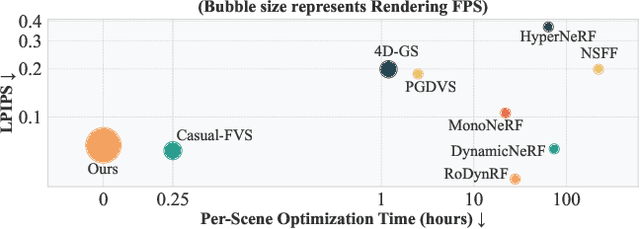
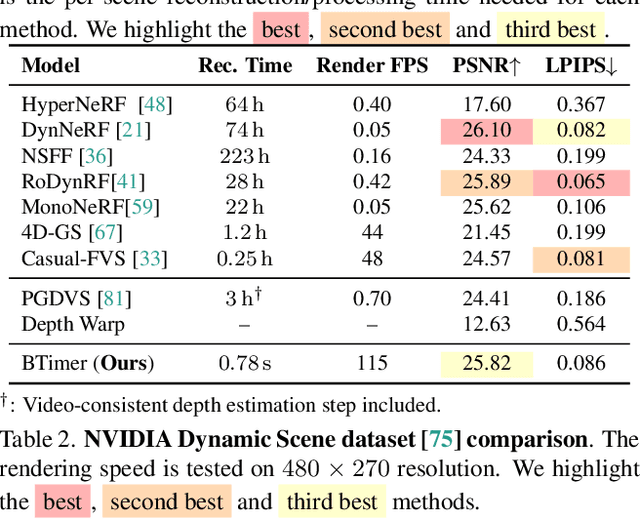
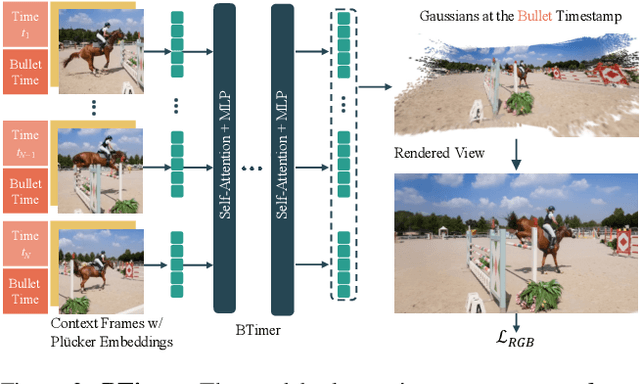
Abstract:Recent advancements in static feed-forward scene reconstruction have demonstrated significant progress in high-quality novel view synthesis. However, these models often struggle with generalizability across diverse environments and fail to effectively handle dynamic content. We present BTimer (short for BulletTimer), the first motion-aware feed-forward model for real-time reconstruction and novel view synthesis of dynamic scenes. Our approach reconstructs the full scene in a 3D Gaussian Splatting representation at a given target ('bullet') timestamp by aggregating information from all the context frames. Such a formulation allows BTimer to gain scalability and generalization by leveraging both static and dynamic scene datasets. Given a casual monocular dynamic video, BTimer reconstructs a bullet-time scene within 150ms while reaching state-of-the-art performance on both static and dynamic scene datasets, even compared with optimization-based approaches.
Adversarial multi-task underwater acoustic target recognition: towards robustness against various influential factors
Nov 05, 2024Abstract:Underwater acoustic target recognition based on passive sonar faces numerous challenges in practical maritime applications. One of the main challenges lies in the susceptibility of signal characteristics to diverse environmental conditions and data acquisition configurations, which can lead to instability in recognition systems. While significant efforts have been dedicated to addressing these influential factors in other domains of underwater acoustics, they are often neglected in the field of underwater acoustic target recognition. To overcome this limitation, this study designs auxiliary tasks that model influential factors (e.g., source range, water column depth, or wind speed) based on available annotations and adopts a multi-task framework to connect these factors to the recognition task. Furthermore, we integrate an adversarial learning mechanism into the multi-task framework to prompt the model to extract representations that are robust against influential factors. Through extensive experiments and analyses on the ShipsEar dataset, our proposed adversarial multi-task model demonstrates its capacity to effectively model the influential factors and achieve state-of-the-art performance on the 12-class recognition task.
DEMONet: Underwater Acoustic Target Recognition based on Multi-Expert Network and Cross-Temporal Variational Autoencoder
Nov 05, 2024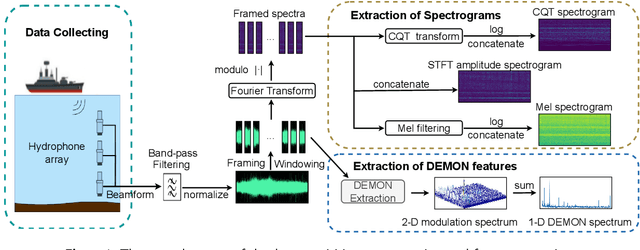
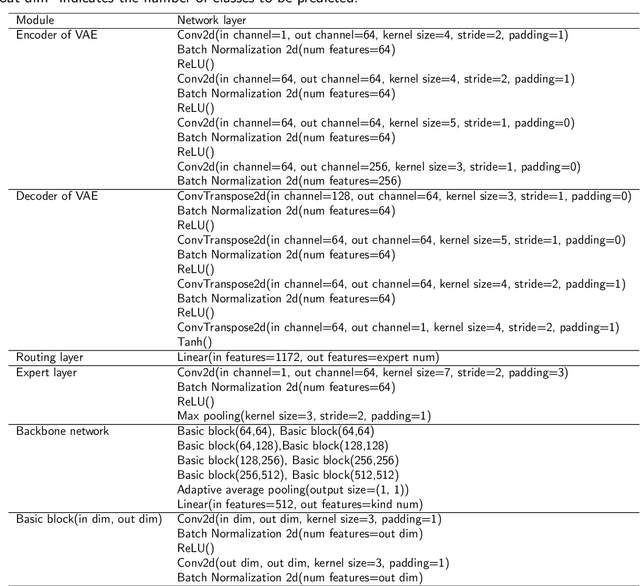
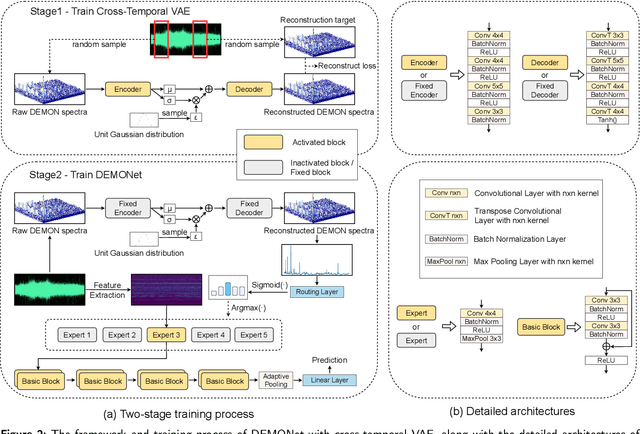

Abstract:Building a robust underwater acoustic recognition system in real-world scenarios is challenging due to the complex underwater environment and the dynamic motion states of targets. A promising optimization approach is to leverage the intrinsic physical characteristics of targets, which remain invariable regardless of environmental conditions, to provide robust insights. However, our study reveals that while physical characteristics exhibit robust properties, they may lack class-specific discriminative patterns. Consequently, directly incorporating physical characteristics into model training can potentially introduce unintended inductive biases, leading to performance degradation. To utilize the benefits of physical characteristics while mitigating possible detrimental effects, we propose DEMONet in this study, which utilizes the detection of envelope modulation on noise (DEMON) to provide robust insights into the shaft frequency or blade counts of targets. DEMONet is a multi-expert network that allocates various underwater signals to their best-matched expert layer based on DEMON spectra for fine-grained signal processing. Thereinto, DEMON spectra are solely responsible for providing implicit physical characteristics without establishing a mapping relationship with the target category. Furthermore, to mitigate noise and spurious modulation spectra in DEMON features, we introduce a cross-temporal alignment strategy and employ a variational autoencoder (VAE) to reconstruct noise-resistant DEMON spectra to replace the raw DEMON features. The effectiveness of the proposed DEMONet with cross-temporal VAE was primarily evaluated on the DeepShip dataset and our proprietary datasets. Experimental results demonstrated that our approach could achieve state-of-the-art performance on both datasets.
Advancing Robust Underwater Acoustic Target Recognition through Multi-task Learning and Multi-Gate Mixture-of-Experts
Nov 05, 2024Abstract:Underwater acoustic target recognition has emerged as a prominent research area within the field of underwater acoustics. However, the current availability of authentic underwater acoustic signal recordings remains limited, which hinders data-driven acoustic recognition models from learning robust patterns of targets from a limited set of intricate underwater signals, thereby compromising their stability in practical applications. To overcome these limitations, this study proposes a recognition framework called M3 (Multi-task, Multi-gate, Multi-expert) to enhance the model's ability to capture robust patterns by making it aware of the inherent properties of targets. In this framework, an auxiliary task that focuses on target properties, such as estimating target size, is designed. The auxiliary task then shares parameters with the recognition task to realize multi-task learning. This paradigm allows the model to concentrate on shared information across tasks and identify robust patterns of targets in a regularized manner, thereby enhancing the model's generalization ability. Moreover, M3 incorporates multi-expert and multi-gate mechanisms, allowing for the allocation of distinct parameter spaces to various underwater signals. This enables the model to process intricate signal patterns in a fine-grained and differentiated manner. To evaluate the effectiveness of M3, extensive experiments were implemented on the ShipsEar underwater ship-radiated noise dataset. The results substantiate that M3 has the ability to outperform the most advanced single-task recognition models, thereby achieving the state-of-the-art performance.
RAG4ITOps: A Supervised Fine-Tunable and Comprehensive RAG Framework for IT Operations and Maintenance
Oct 21, 2024Abstract:With the ever-increasing demands on Question Answering (QA) systems for IT operations and maintenance, an efficient and supervised fine-tunable framework is necessary to ensure the data security, private deployment and continuous upgrading. Although Large Language Models (LLMs) have notably improved the open-domain QA's performance, how to efficiently handle enterprise-exclusive corpora and build domain-specific QA systems are still less-studied for industrial applications. In this paper, we propose a general and comprehensive framework based on Retrieval Augmented Generation (RAG) and facilitate the whole business process of establishing QA systems for IT operations and maintenance. In accordance with the prevailing RAG method, our proposed framework, named with RAG4ITOps, composes of two major stages: (1) Models Fine-tuning \& Data Vectorization, and (2) Online QA System Process. At the Stage 1, we leverage a contrastive learning method with two negative sampling strategies to fine-tune the embedding model, and design the instruction templates to fine-tune the LLM with a Retrieval Augmented Fine-Tuning method. At the Stage 2, an efficient process of QA system is built for serving. We collect enterprise-exclusive corpora from the domain of cloud computing, and the extensive experiments show that our method achieves superior results than counterparts on two kinds of QA tasks. Our experiment also provide a case for applying the RAG4ITOps to real-world enterprise-level applications.
L4GM: Large 4D Gaussian Reconstruction Model
Jun 14, 2024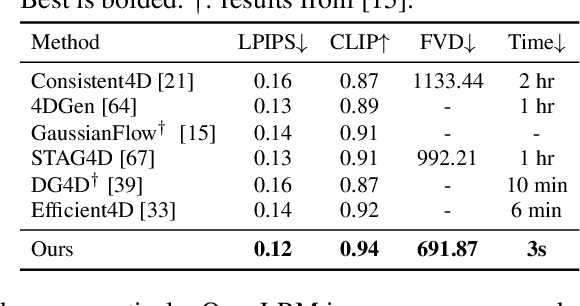
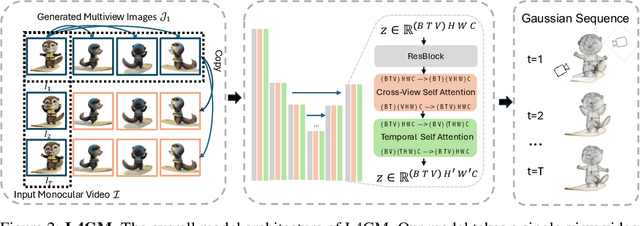

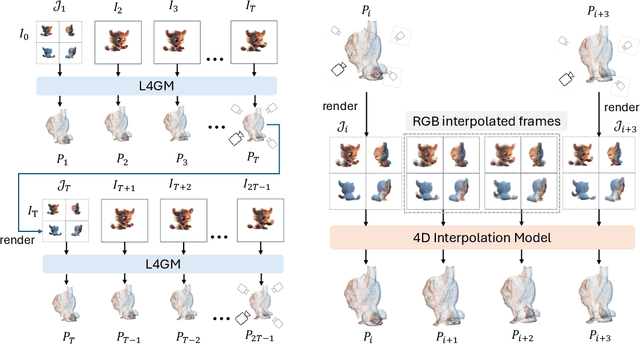
Abstract:We present L4GM, the first 4D Large Reconstruction Model that produces animated objects from a single-view video input -- in a single feed-forward pass that takes only a second. Key to our success is a novel dataset of multiview videos containing curated, rendered animated objects from Objaverse. This dataset depicts 44K diverse objects with 110K animations rendered in 48 viewpoints, resulting in 12M videos with a total of 300M frames. We keep our L4GM simple for scalability and build directly on top of LGM, a pretrained 3D Large Reconstruction Model that outputs 3D Gaussian ellipsoids from multiview image input. L4GM outputs a per-frame 3D Gaussian Splatting representation from video frames sampled at a low fps and then upsamples the representation to a higher fps to achieve temporal smoothness. We add temporal self-attention layers to the base LGM to help it learn consistency across time, and utilize a per-timestep multiview rendering loss to train the model. The representation is upsampled to a higher framerate by training an interpolation model which produces intermediate 3D Gaussian representations. We showcase that L4GM that is only trained on synthetic data generalizes extremely well on in-the-wild videos, producing high quality animated 3D assets.
Benchmarking and Improving Bird's Eye View Perception Robustness in Autonomous Driving
May 27, 2024Abstract:Recent advancements in bird's eye view (BEV) representations have shown remarkable promise for in-vehicle 3D perception. However, while these methods have achieved impressive results on standard benchmarks, their robustness in varied conditions remains insufficiently assessed. In this study, we present RoboBEV, an extensive benchmark suite designed to evaluate the resilience of BEV algorithms. This suite incorporates a diverse set of camera corruption types, each examined over three severity levels. Our benchmarks also consider the impact of complete sensor failures that occur when using multi-modal models. Through RoboBEV, we assess 33 state-of-the-art BEV-based perception models spanning tasks like detection, map segmentation, depth estimation, and occupancy prediction. Our analyses reveal a noticeable correlation between the model's performance on in-distribution datasets and its resilience to out-of-distribution challenges. Our experimental results also underline the efficacy of strategies like pre-training and depth-free BEV transformations in enhancing robustness against out-of-distribution data. Furthermore, we observe that leveraging extensive temporal information significantly improves the model's robustness. Based on our observations, we design an effective robustness enhancement strategy based on the CLIP model. The insights from this study pave the way for the development of future BEV models that seamlessly combine accuracy with real-world robustness.
Multi-Modal Data-Efficient 3D Scene Understanding for Autonomous Driving
May 08, 2024



Abstract:Efficient data utilization is crucial for advancing 3D scene understanding in autonomous driving, where reliance on heavily human-annotated LiDAR point clouds challenges fully supervised methods. Addressing this, our study extends into semi-supervised learning for LiDAR semantic segmentation, leveraging the intrinsic spatial priors of driving scenes and multi-sensor complements to augment the efficacy of unlabeled datasets. We introduce LaserMix++, an evolved framework that integrates laser beam manipulations from disparate LiDAR scans and incorporates LiDAR-camera correspondences to further assist data-efficient learning. Our framework is tailored to enhance 3D scene consistency regularization by incorporating multi-modality, including 1) multi-modal LaserMix operation for fine-grained cross-sensor interactions; 2) camera-to-LiDAR feature distillation that enhances LiDAR feature learning; and 3) language-driven knowledge guidance generating auxiliary supervisions using open-vocabulary models. The versatility of LaserMix++ enables applications across LiDAR representations, establishing it as a universally applicable solution. Our framework is rigorously validated through theoretical analysis and extensive experiments on popular driving perception datasets. Results demonstrate that LaserMix++ markedly outperforms fully supervised alternatives, achieving comparable accuracy with five times fewer annotations and significantly improving the supervised-only baselines. This substantial advancement underscores the potential of semi-supervised approaches in reducing the reliance on extensive labeled data in LiDAR-based 3D scene understanding systems.
Move Anything with Layered Scene Diffusion
Apr 10, 2024



Abstract:Diffusion models generate images with an unprecedented level of quality, but how can we freely rearrange image layouts? Recent works generate controllable scenes via learning spatially disentangled latent codes, but these methods do not apply to diffusion models due to their fixed forward process. In this work, we propose SceneDiffusion to optimize a layered scene representation during the diffusion sampling process. Our key insight is that spatial disentanglement can be obtained by jointly denoising scene renderings at different spatial layouts. Our generated scenes support a wide range of spatial editing operations, including moving, resizing, cloning, and layer-wise appearance editing operations, including object restyling and replacing. Moreover, a scene can be generated conditioned on a reference image, thus enabling object moving for in-the-wild images. Notably, this approach is training-free, compatible with general text-to-image diffusion models, and responsive in less than a second.
Guiding the underwater acoustic target recognition with interpretable contrastive learning
Feb 20, 2024Abstract:Recognizing underwater targets from acoustic signals is a challenging task owing to the intricate ocean environments and variable underwater channels. While deep learning-based systems have become the mainstream approach for underwater acoustic target recognition, they have faced criticism for their lack of interpretability and weak generalization performance in practical applications. In this work, we apply the class activation mapping (CAM) to generate visual explanations for the predictions of a spectrogram-based recognition system. CAM can help to understand the behavior of recognition models by highlighting the regions of the input features that contribute the most to the prediction. Our explorations reveal that recognition models tend to focus on the low-frequency line spectrum and high-frequency periodic modulation information of underwater signals. Based on the observation, we propose an interpretable contrastive learning (ICL) strategy that employs two encoders to learn from acoustic features with different emphases (line spectrum and modulation information). By imposing constraints between encoders, the proposed strategy can enhance the generalization performance of the recognition system. Our experiments demonstrate that the proposed contrastive learning approach can improve the recognition accuracy and bring significant improvements across various underwater databases.
 Add to Chrome
Add to Chrome Add to Firefox
Add to Firefox Add to Edge
Add to Edge